Futures contracts have been slowly creeping up the 90% range, standing presently at a 96% probability for a 25-basis point rate hike as convictions have grown deeper that the Central Bank meant what it said about arresting stubbornly high inflation. Chair Powell, along with many of his colleagues, have made it abundantly clear that the Fed has some more work to do in terms of bringing restrictive policy to higher ground, yet the consensus among policymakers suggests that the end of the tightening cycle is near. Of course, there are those that would argue that the Fed has essentially completed its task, with this month likely to see a final rate increase for the cycle, as odds of a September rate hike are thus far uninspiring. There is clearly sufficient evidence in hand to make the case that the Fed’s 500-basis points of tightening is driving the pace of inflation lower, although the disinflationary pull must retain its grip or else the Central Bank is at risk of a policy miscalculation. Although the recession narrative remains integral to the investment calculus, we find it appropriate at this time to re-characterize our landing outlook from “braced” to “soft-ish” with the understanding that recession may still come and that unforeseen events could return our view to the less optimistic expectation, with one such event potentially taking the form of a policy error. Given the remarkable resiliency demonstrated by the domestic economy and the receding pace of inflation, many market participants have had to recalibrate their expectations for recession, ourselves included. Should recession appear in the first half of 2024, we continue to anticipate a shallow downturn of relatively short duration. If yield curve inversion is any guide, recession still looms out there, but again we would expect to see a bull-steepening pathway before the onset of recession likely to materialize if the Fed concludes its tightening cycle in July. Should such steepener emerge by year-end, we suspect that it would stick around for much of 2024.
The Fed will be seeking consistency in subsequent economic data points and the need to pull wage growth lower and reduce job formation will be front and center on its radar screen as a resilient labor market is the key underlying force behind stubbornly high inflation. However, it will be a cooling labor market that will have a heavy hand in bringing down price pressure. We believe that disinflation has finally found its footing amid slowing economic conditions and that headline CPI could be inspired to dip below 3% by year-end as the normalization process seems to be underway. It is this very progress on inflation that has led many stakeholders to conclude that the July FOMC meeting would likely deliver the last rate hike of the current tightening cycle. More hawkish interests would argue that the economy is still a long way from the Fed’s 2% target and so more than one additional rate increase would likely be necessary. After 500-basis points of tightening, the employment backdrop remains tight with limited weakness, market participants have managed to navigate the volatile waters effectively and efficiently, bank stress contagion has been contained, and despite noted softening, the consumer has proven quite reliable. In our view, the coming months will likely be exposed to the vagaries of energy prices, political engagement ahead of the 2024 presidential election, potential dislocation in the commercial real estate market, and evolving banking pressure given revised capital requirements.

There is certainly no shortage of deployable cash and once rates stabilize, we should expect to see more consistent inflow activity.
Munis were more than happy to ride the positive bond vibe of late as tax-exempts are modestly outperforming U.S. Treasury securities month-to-date. Year-to-date returns clearly show munis out in the lead, 3.34% versus 1.67% respectively. There is certainly no shortage of deployable cash and once rates stabilize, we should expect to see more consistent inflow activity. Even with tempered rate volatility, new-issue volume will likely be lower year-over-year at year-end, at or close to a 20% delta. For now, a net-negative supply backdrop should promote technical support for municipal bonds, and it is this support that will drive performance through the balance of the year. New-money issuance should eclipse refunding volume as the rate environment will not likely provide fertile ground to transact municipal refundings, yet we can still expect to see year-over-year monthly declines in both new-money and refunding issuance. Muni credit has held up quite well, with upgrades surpassing downgrades and defaults largely confined to inherently weaker sectors of the market, such as senior living, conduit housing and project finance. Prior rounds of stimulus funds have provided issuers with operational and financial flexibility, but as that pipeline closes, many can rely upon strong, albeit softening in places, revenue collections and ample reserve balances. After reflecting a disproportionate share of Moody’s negative outlooks across multiple sectors in 2020, assignment of stable outlooks became prevalent in 2022, with two positive outlooks downgraded to stable (airports and toll roads) and public/private higher education sector outlooks lowered from stable to negative in 2023. The hospital sector has kept a negative Moody’s outlook. Given where we are in the economic cycle, we are comfortable with a stable outlook for the airport sector, with the understanding that airports in general should be able to withstand the effects of a presumably mild recession. For now, bookings are robust with leisure travel in strong demand and business travel on the upswing. Airports entered the economic shutdown from a position of strength as many enterprises possessed strong levels of liquidity and viable cost recovery mechanisms. The future outlook for the airport sector will have to reflect fuel cost variability, contract negotiations, appropriate staffing levels, competitive forces, ongoing safety standards, and the most cost-effective and efficient travel routes. Generally, the airport sector can provide well-diversified portfolios with investment options containing strong credit characteristics, stable and predictable cash flow, and market liquidity.
The challenges confronting the higher education sector may be less about an economic downturn and more about shifting demographic patterns, the value proposition of a conventional four-year degree, and evolving preferences for academic delivery, particularly post-COVID. As we make our credit assessments for the higher education sector, we find ourselves spending a fair amount of time on management/governance issues, which in our view often take on the greatest significance of ESG consideration. A school must have a clearly defined mission statement that can be articulated across multiple stakeholder groups, must display adaptability prowess as academic delivery models may require a less conventional strategic approach, and must be nimble enough to preserve credit standing as a diminution of financial resources potentially takes hold. Investment quality portfolios are advised to seek out those colleges and universities that exhibit robust balance sheets with good liquidity, sound operations with adequate revenue diversification, brand recognition, and a proven capacity to strategize a successful fund-raising campaign. The healthcare sector will likely remain under stress, particularly as efforts to normalize operations in a post-pandemic environment present challenge. We have all heard about the heavy labor shortages that have created the need to contract higher paid visiting nurses and that have disrupted hospital operations at a time when more profitable elective procedures were supplanted by COVID-driven ER and ICU caseloads. For certain providers, margins have shown improvement, while others are still struggling to strengthen their income statements, with staffing needs having to be addressed. Going forward, we advise a more discerning approach when considering hospital bond investments. Similar to our higher education guidance, we suggest a focus on those providers having balance sheet strength and flexibility, favorable operational performance, a sound geographic footprint in state or on a multi-state landscape, a clearly defined mission statement, and a competitive stronghold.

Jeff Lipton
Title:Managing Director, Head of Municipal Credit and Market Strategy
85 Broad Street
26th Floor
New York, New York 10004

